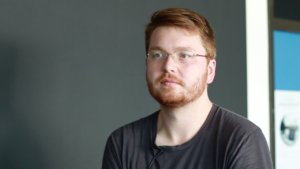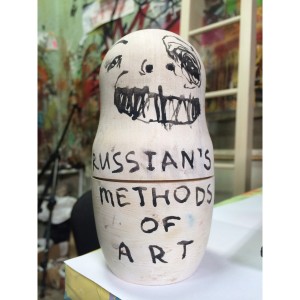There are maybe in simplified terms two structures. On the one hand what we would call an institutional frame that has been created for artistic dispositives. In Germany those are of course the art clubs founded by the citizens in the mid-19th and early 20th century. Then of course the institutions such as museums or galleries. And of course art halls, so houses without their own collections. And this does of course also exist as an international model. Currently, I exhibit in an art museum in Seoul, called CAN Space, which is supervised by a professional curator, who has already curated several biennials. In a team where the employee also has worked in galleries. This is all highly professional. The present monographic exhibitions in cycles, and deal with one particular question for a whole year. As one of the last stations of an exhibition tourney initiated by Goethe Institute, I showed Platon’s Mirror in there. On the other hand there is the non-institutional or not-prepared frame. The works from a collaboration between architecture or university. I had just mentioned Metalicht or Megazeichen as an example. There is something like a cooperative framing. Either an institution such as a university or a company like Mannesmann or a bunker, which belongs to the cityscape of a city like in Lüneburg. The frame, the dispositive is formed by dealing with the location and by the marking of the place. And this creates an exhibition platform on time. If we called this 2a in the non-institutional framework, 2b would be the performance frame. The performance frame for the Black Square in Hamburg would be 90minutes or the 400 sheep in Bern or the window cleaners in Toronto. This also means the models on time are not effective, but rather a performance direction, registered as a demonstration or applied as a performance intervention in urban space. This refers to my big project plan with the public prepositions where Solidarity Grid in the Christchurch belongs to. So sometimes the work itself has to find or define or co-constitute its location and by this the artwork co-builts its art-receptive frame. This means, when an artist produces an artwork, there are always these statements: yeah, but if I do it then nobody cares about it. This is a fact, because the artist as a person and in profession always commits something, that has some sort of artwork quality or process quality to the artistic context, and thus also to the social context. And this commitment is the agreement. One can see this very well in the re-evaluation of the exhibition Attitudes Become Form by Harald Szeemann, where the artists 1969 (I just have seen all the statements in Venice) said something like: Yes, I do art. I am an artist – I do art. And this was the only answer that the journalist was able to squeeze of these artists in 1969. Now one could also just say that but I think that the relationship between the artist and society has become more complex. And it was right in 1969, during the time between 1967 and 1969 where in Berkeley, Paris and Frankfurt and elsewhere the student revolt came up with the question: how did the parent generation actually deal with the problems of the Vietnam War and the 2nd World War? In the context of that question political systems and models of representation have been questioned and therefore the museums had of course a very different social task with this type of art. Which is much more complex. You can see it in the artistic manifestations, if one takes Alice Creischer or Andreas Siekmann or just Alfredo Jaar. I mean how complex artistic statements are, which are so highly politically loaded up in the work contexts. This can be retold without effort, I guess. 1969 it was a gesture of radicalism to say: art has no other meaning except for being art. Me, being Lawrence Weiner, just rip out this square out of the wall. I rip off the plaster and I just do it because it simply has to be done at this point. So. That’s it. And the first argument maybe goes beyond this point, regarding the issue of which part the artist should have.
The audience, forms itself. Either away … haha (laughs), so not away from the location, but they continue their studies in the sense of educating themselves from the artworks. This is of course the task of the museums. I think the biggest increase is the education department of the museum. Perhaps it is also an invention of the mid-20th century to say that you have to take the children and young people along to give them the chance to later understand the possibilities of encoding and coding from the artistic to the other perspective. I am not sure if it is the right way as it is done right now. But it is one way that is being operated. I also know directors of museums who are more sceptical about it. So not all follow this credo. The other audience is an audience that does not know that they are an audience. So for example the people who passed Megazeichen in a car not knowing what it was and then there was this reaction in the newspaper: the cleaners had forgotten to switch off the light, and so on. Those are the reactions that tell us, that there is an unprepared audience, which also reacts just like someone who is unprepared.
Da gibt es vielleicht vereinfacht, vergröbert, zwei Strukturen. Einmal das, was wir als einen institutionellen Rahmen bezeichnen würden, der für künstlerische Dispositive geschaffen worden ist. Das sind in Deutschland natürlich ganz vorne weg die Bürger aus der bürgerlichen Mitte entstandenen Kunstvereine. Aus der Mitte des 19. und Anfang des 20. Jahrhunderts. Dann natürlich die Institutionen wie städtische Museen oder Landesgalerien. Dann natürlich eben Kunsthallen, also Häuser ohne eigene Sammlung. Und das gibt es natürlich auch als ein internationales Modell. Gerade aktuell zeige ich, wenn man so will, in einer Kunsthalle in Seoul, die heißt CAN Space und wird von einer professionellen Kuratorin betreut, die schon mehrere Biennalen kuratiert hat. In einem Team wo auch der Mitarbeiter schon in Galerien gearbeitet hat. Das ist alles hoch professionell. Die zeigen zyklenhaft monografische Ausstellungen, die dann immer auf das gesamte Jahr gesehen einer bestimmten Fragestellung folgen. In dem Fall zeige ich dort „Platon´s Mirror“ als eine der letzten Ausstellungsstationen, dieser vom Goethe Institut initiierten Ausstellungstournee. Dann gibt es den nicht-institutionellen oder noch nicht vorbereiteten Rahmen. Das ist dann sozusagen aus der Kooperation zwischen Architektur oder eben Universität. Ich hatte gerade „MetaLicht“ oder „Megazeichen“ als ein Beispiel genannt. Da gibt es ja praktisch dann einen Cooperate Rahmen, wenn man so will. Entweder eine Institution wie Universität oder eine Firma wie Mannesmann oder einen Bunker, der sozusagen ins Stadtbild einer Stadt gehört wie in Lüneburg. Und da bildet sich der Rahmen, das Dispositiv durch die Beschäftigung mit dem Ort und durch die Markierung des Ortes. Und dadurch entsteht eine Ausstellungsplattform auf Zeit. Wenn das im nicht-institutionellen Rahmen jetzt 2a wäre, dann wäre 2b das im performativen Rahmen. Für das „Black Square“ in Hamburg 90min, oder die 400 Schafe in Bern oder die Fensterputzer in Toronto. Das heißt auch dort greifen nicht diese Modelle auf Zeit, sondern sozusagen eher eine performative Wegebeschreibung, als Demonstration angemeldet oder als eine Performance angemeldete Intervention im Stadtraum. Das rekurriert ja auf mein großes Projektvorhaben mit dem „public prepositions“ wo ja „Solidarity Grid“ in Christchurch mit dazu gehört. Also manchmal muss die Arbeit erst mal ihren Ort finden oder definieren oder mitkonstituieren und damit bildet sie ja auch einen in kunstrezeptiven Rahmen mit. Das heißt, wenn ein Künstler ein Werk macht, dann gibt es ja immer wieder diese Aussagen: Jaja, wenn ich das mache dann nimmt das ja keiner wahr. Das ist ja klar, der Künstler als Person und in Profession übergibt immer etwas, was Werkqualität oder Prozessqualität hat, in den künstlerischem Kontext, und damit eben auch gesellschaftlichen Kontext, ein. Und diese Einschreibung ist die Vereinbarung. Man kann das jetzt aktuell sehr gut an der Re-Evaluierung der Ausstellung „Attitudes Become Form“ von Harald Szeemann sehen, wo die Künstler 1969 (ich habe die Statements jetzt alle wieder in Venedig gesehen), dann so etwas gesagt haben wie: Ja, ich mache Kunst. Ich bin Künstler, ich mache Kunst. Und das war die einzige Begründung, die der Journalist, den Künstlern 1969 aus der Nase ziehen konnte. Jetzt kann man das ja heute auch einfach behaupten und wieder so sagen, aber ich glaube, dass das Verhältnis zwischen Künstler und Gesellschaft mittlerweile etwas komplexer ist. Und das 69 richtig war. In der Zeit zwischen 67 und 69 wo in Berkley Paris und Frankfurt und anderswo studentische Revolte entstanden ist, mit der Frage: Wie ist eigentlich die Elterngeneration mit den Problemen von Vietnamkrieg über den 2. Weltkrieg umgegangen? Und dass in diese Fragestellung hinein eben politische Systeme und Repräsentationsmodelle hinterfragt worden sind und da hatte die Institution Museum mit dieser Art von Kunst natürlich eine ganz andere gesellschaftliche Aufgabe. Die ist viel komplexer. Das sieht man auch an den künstlerischen Ausformungen, wenn man Alice Creischer nimmt oder Andreas Siekmann oder eben Alfredo Jaar. Also wie komplex da künstlerische Aussagen sind, die ja hochgradig politisch auch aufgeladen sind an den jeweiligen Werkzusammenhängen. Das lässt sich mühelos, glaube ich, weiter erzählen. 69 war es eine Geste in der Radikalisierung zu sagen: Die Kunst hat gar keine andere Bedeutung als Kunst zu sein. Ich haue jetzt hier als Lawrence Weiner dann eben dieses Quadrat da aus der Wand. Schlage dem Plaster Putz ab und mache das, weil es eben an dieser Stelle gemacht werden muss. So. Punkt. Und über diese erste Argumentation geht es vielleicht ein Stückchen hinaus, was die Rolle des Künstlers angeht.
Das Publikum, das bildet sich. Entweder fort… haha (lacht), also nicht fort vom Ort, sondern bildet sich fort im Sinne von: Bildet sich an den Werken. Das ist natürlich dann die Aufgabe des Museums. Ich glaube der größte Zuwachs ist die pädagogische Abteilung des Museums. Ist vielleicht auch die Erfindung des, in Mitte des 20. Jahrhunderts zu sagen, dass man die Kinder und Jugendlichen mitnehmen muss, damit sie später überhaupt auch die Chiffriermöglichkeiten und Kodierungen aus der künstlerischen in die andere Perspektive verstehen. Ich bin mir nicht sicher, ob das der richtige Weg ist, so wie es gemacht wird. Aber es ist ein Weg, der betrieben wird. Ich kenne auch Museumsleiter, die da eher skeptisch sind. Also nicht alle folgen diesem Kredo. Das andere Publikum ist das Publikum, das gar nicht weiß, dass es ein Publikum ist. Also die Leute, die zum Beispiel an dem „Megazeichen“ mit dem Auto vorbei gefahren sind und gar nicht wussten was das war und dann gab es ja auch diese Reaktion in der Zeitung: Die Putzfrauen hätten vergessen das Licht auszumachen usw. Das sind ja eben die Reaktionen, die auch erzählen, dass es eben ein unvorbereitetes Publikum gibt, das eben auch so reagiert wie jemand, der unvorbereitet ist.

















